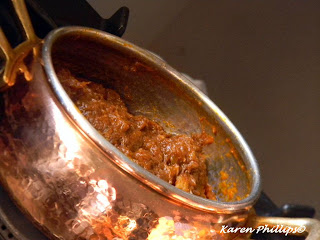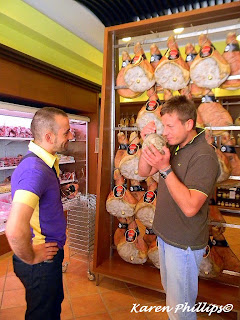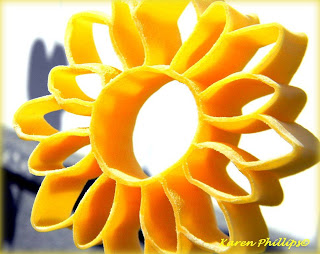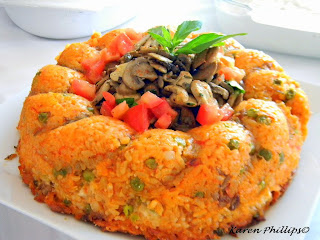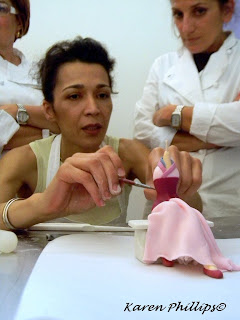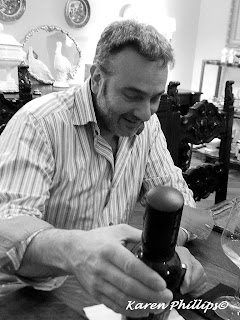 |
| Roberto Di Meo |
It was only last January when I put a face to the name. I saw
Roberto Di Meo, president of Assoenologi Campania, a leading enologist association and one of the top winemakers in Campania, for the first time - in person. I was sitting in a small theater during Taurasi Vendemmia 2008 and Di Meo was there, discussing Taurasi's macroareas, the climate, the terroir. An informative evening that led me to present myself to Di Meo that evening at dinner. The usual exchange of business cards and a silent promise to myself to visit his winery soon ish...
A silent promise that I repeated in March when I stopped by Cantine Di Meo's booth in Verona at Vinitaly. Right after tasting Di Meo's Fiano Di Avellino...right after Di Meo mentioned that he had a couple of older vintages waiting in the vat back home in Salza Irpina..
So one late afternoon I went to fulfill that silent promise. Contrada Coccovoni, 1. Cantine Di Meo. I buzzed the gate...
Ciao, So
no Karen....
Ciao...vieni in fondo...Come to the back...
I'll be with you in a just a moment...Di Meo was a little behind schedule, but no problem. I took the golden opportunity to walk the grounds with Tonino Della Porta, who filled me in a little bit of cantina news. We walked past Fiano vinyards ranging in age from 2 to 15 years old. Some with the vecchia sysem, but slowly being replaced by newer vineyards whuch would challenge the vines, challenge the grapes to give be all that they could be...quality, not quantity was the key here. Tonino showed me a cantina in progress..a new facility which was being built on site so that Di Meo would have more space for his custom made stainless steel vats, his barrel room, bottling facilities, and futre offices. This was a winery who was expanding...and rightly so We continued past olive, apricot, and mulberry trees. We continued our stroll, our passeggiata down the road until we reached an 18th century renovated farm house...and Roberto Di Meo
Di Meo unlocked the door and led me into a
casa...a home. On display, a variety of older bottles with mixed in with the new ones. Old classic labels fused in with Di Meo's new sleek bottles. Back in 2003, Di Meo decided to change the bottles...simplify them. F for Fiano di Avellino...G for Greco di Tufo...etc, etc. An idea that he hoped would help his wines stand out on the shelves, particularly in the international market...
But of course, the true test is not what's on the label. It's what's inside. Time to taste a few wines in the dining room seated at a large wooden table. Two glasses...Italian classics by Pavarotti and Boccelli on the stereo. Ready, set, go...
C is for Coda di Volpe. We began with
Coda di Volpe Campania IGT 2011 made from three grapes...75 % Coda di Volpe...15 % Fiano di Avellino and 10 % Greco di Tufo. I believe Di Meo choose this fusion of Irpinia whites to give this wine not only the intense aromas, but the flavor balance that he is looking for.
F is for Fiano, so Di Meo, a self confessed
fiano fanatic poured me a glass of his latest
Fiano Di Avellino DOCG 2011. A wine made from the vineyards that I had seen earlier surrounding this comfortable tasting room. This wine spends time in stainless steel only before bottled. Light straw in color...fresh...flavorfull. Perfect for lazy afternoon lunches, light summer dinners.
Time to move on to the next Fiano...Di Meo's
Colli dei Cerri Fiano di Avellino DOC 2005.
Color here was an instant indication that this Fiano was different than the first.A deeper color due primarily to 12 days or so macerating with the grape skins...8 to 10 months on the lees. Di Meo lets this wine spend about 10 months in barrique as well. All to produce a Fiano
elegante. Perfect for those meals that call for a white wine, but one with a little more structure.
Di Meo had two more Fianos for me to try...his samples from the vats...his older vintages.
Sono grezzi...he tells me, rustic. These wines have been in progress for awhile, one since 2000 and the other 2001. Each spent about two years on the lees, have been transfered a few times, and the
basta...
Non c'e fretta, says Di Meo...no rush. He just wants to see where this Fiano will go. I fell in love with the aromas of apples and apricots... I was impressed by the the freshness in each glass. 2000? wow.
R is for rosato. In this case, Di Meo's
Aglianico Rosato Campania 2011 made with Aglianico grapes.
Notes of light fruit and florals...grapes from Mirabella Eclano chosen to give this wine the freshness Di Meo wanted. And as warm as it gets over the summer, this rose' is the perfect
red that can be paired with light summer meals such as pasta, fish, and white meat. It would also work well as an aperitif...with cheeses and salamis, which by chance happened to be on the table.
Di Meo's caciocavallo cheese that spends a month in bathing in his red wine. Then it patiently rests for three months (
Non c'e' fretta...) before receiving daily massages in the family's extra virgin olive oil and Taurasi. Every day for 30 days then left to age...Light to the touch...with a powerful punch when tasted...
A is for Aglianico.
Aglianico Campano IGT 2008.
Imagine the evolution I experienced in my glass over the next serveral minutes. Aromas that were opening up after a year of wood (barriques and large barrels), then time in stainless steel before maturing in the bottle. Intense at first, but then slowly opening up. Imagine what I experienced when I tried my next glass...
T is for Taurasi, and in this case,
Taurasi Riserva DOCG 2004. Grapes from the family's vineyards in Montemarano 650 meters above sea level. A young
riserva...young because it still was slightly tannic, but not overpowering. 2 years in Slovenian barrels and French oak barrique, though Di Meo did mention that he likes to leave a little in stainless steel to maintain that freshness he is looking for. I could imagine what this wine would be like in a few years...
Next I was given a spoon...a tiny spoon so that I could try
crema di ratafia. A spoonfull of this rich spread made with chocolate and
ratafia, the Di Meo family's liqueur. A liquer which I had a chance to try next...
Il Ratafia di nonna Erminia...made with Taurasi wine, aged 6 years in wood before it hits the bottle. Intense flavor, spectacular aromas.
Speaking of aromas, Roberto took out the last two bottles...my tasting was coming to an end. But we weren't going to taste...just smell.
Two napkins, one spray each of Di Meo's Taurasi and Fiano perfume...This was an unexpected surprise. And I was obviously full of questions, like when and where could I find theses products.
Non c'e' fretta...No rush...Just little experiments to satisfy his curiosity while at the same time peaking mine.
Another silent promise...
Cantine Di Meo
Contrada Coccovoni 1,
83050 Salza Irpina (Av)
39 0825 981419







